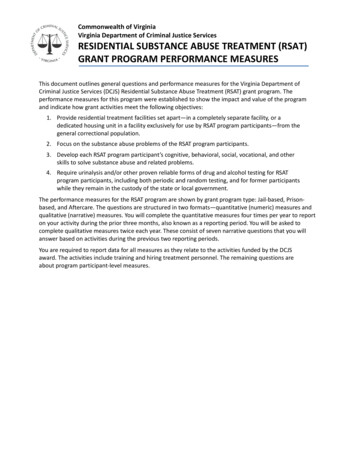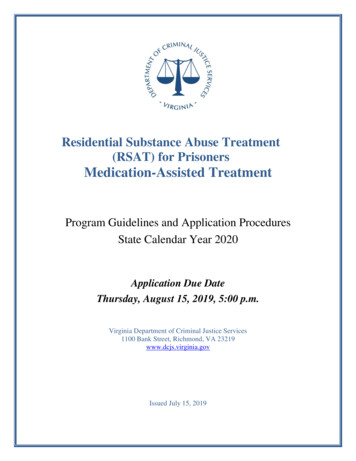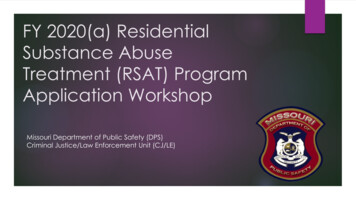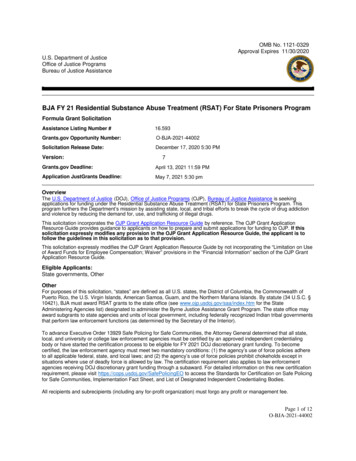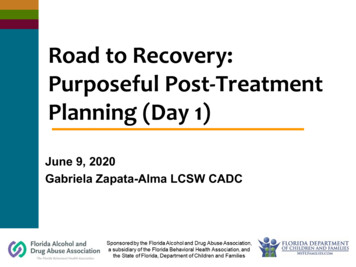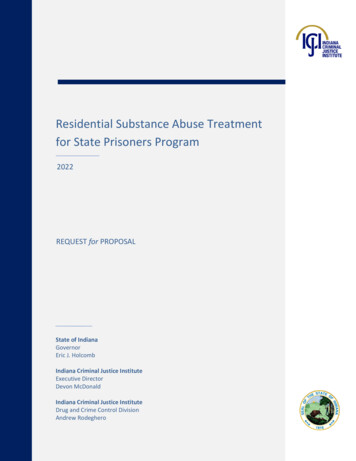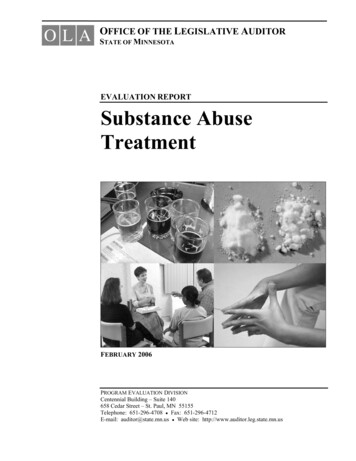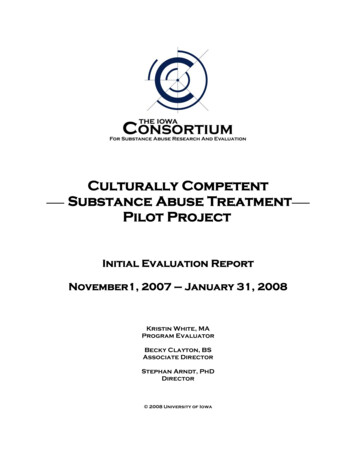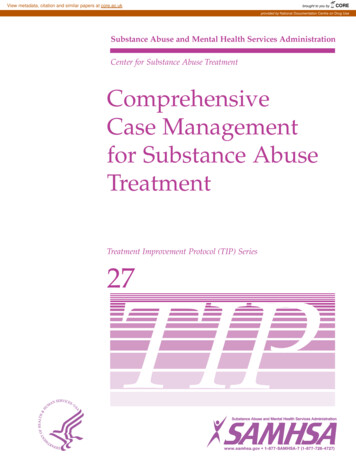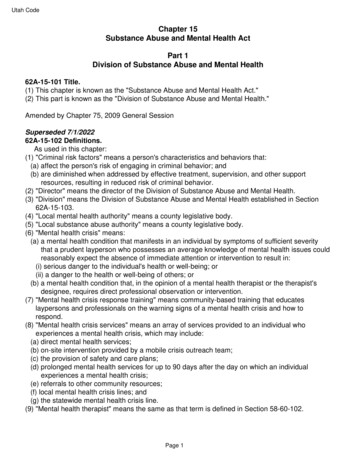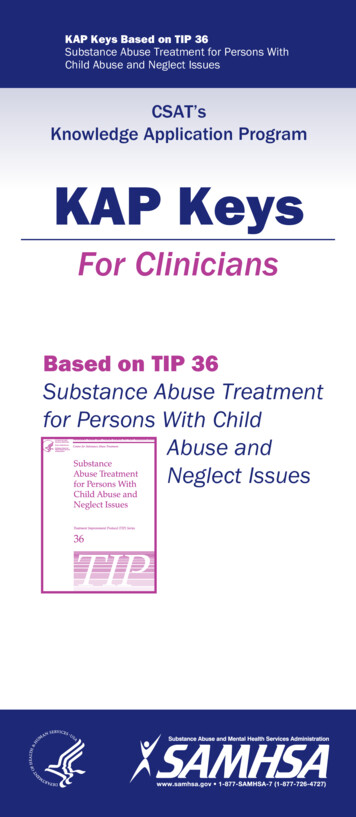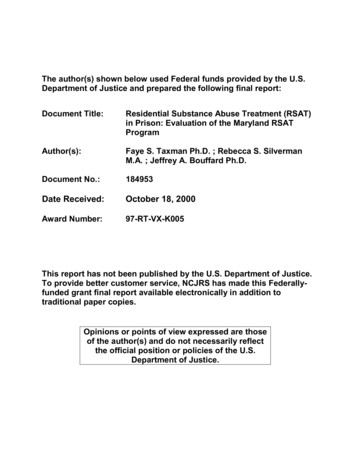
Transcription
The author(s) shown below used Federal funds provided by the U.S.Department of Justice and prepared the following final report:Document Title:Residential Substance Abuse Treatment (RSAT)in Prison: Evaluation of the Maryland RSATProgramAuthor(s):Faye S. Taxman Ph.D. ; Rebecca S. SilvermanM.A. ; Jeffrey A. Bouffard Ph.D.Document No.:184953Date Received:October 18, 2000Award Number:97-RT-VX-K005This report has not been published by the U.S. Department of Justice.To provide better customer service, NCJRS has made this Federallyfunded grant final report available electronically in addition totraditional paper copies.Opinions or points of view expressed are thoseof the author(s) and do not necessarily reflectthe official position or policies of the U.S.Department of Justice.
Faye S. Taxman, P1i.D.Rebecca S. Silverman. M.A.Jeffrey A. Bouffard. Ph.D.This document is a research report submitted to the U.S. Department of Justice. This reporthas not been published by the Department. Opinions or points of view expressed arethose of the author(s) and do not necessarily reflect the official position or policies of theU.S. Department of Justice.
Table of ContentsExecutive Summary-1Chapter 1 Literature ReviewI. Changing Behaviors11. What is a Therapeutic CommunityA. Definition of a TCB. Characteristics of a TCC. Cognitive-Behavioral Approach Within a TC111. Effectiveness of TC ComponentsIV. Unanswered Questions123346811Chapter 2 - Data Collection MethodsI. Systematic Social Observation11. Observation MethodologyA. Purpose of the ObservationsB. Observation InstrumentTable 1 - Five Components of the Structured ObservationInstrumentC. Coding of Observation ItemsD. Observation ScheduleE. Multiple Observations and Inter-Rater ReliabilityTable 2 - Percent of Scale Items Rated Within 1 Scale Pointby Both RatersF. Analysis of Observational Data111. Other Ebaluation MethodologiesA. Data Collection on Client Characteristics and Program PracticesB. Structured Interviews1313191919Chapter 3 - Site and Program Design OverviewI. Site and Program DescriptionA. Physical SettingB. RSAT Staff QualificationsC. Intended Program Design1. Program PhasesTable 3 - Number and Type of Classes Offered toMaryland RSAT Clients2. Curriculum Objectives11. RSAT ImplementationA. Selectibn of ClientsB. Placement ProceduresC. Client Requirements for Participation in RSATD. Program SizeE. Incentives for Client ParticipationF. Drug Testing ProceduresG. Aftercare ProceduresThis document is a research report submitted to the U.S. Department of Justice. This reporthas not been published by the Department. Opinions or points of view expressed arethose of the author(s) and do not necessarily reflect the official position or policies of theU.S. Department of 36363737'I
Chapter 4 - Results- Program Implementation and Client CharacteristicsI. Treatment Schedule and Meeting TypesA. Phase1B. Phase1111. Client Characteristics and Program ProcessesA. Demographic InformationTable 4 - Client Demographic CharacteristicsB. Client Criminal HistoryTable 5 - Client Criminal History CharacteristicsC. Substance Abuse CharacteristicsTable 6 - Substance Abuse CharacteristicsD. Graduated SanctionsTable 7 - Graduated Sanction UseE. Drug TestingTable 8 - Drug TestingF. Length of Time in TreatmentTable 9 - Length of Time in TreatmentG. Continuum of CareTable 10 - Continuum of Care hapter 5 - Observation ResultsI. Structured Observation ResultsA. Program EmphasisTable 11- Mean Program Emphasis Ratings for Each ProgramLevel (Phase I)B. Treatment TopicsTable 12 - Treatment TopicsC. Treatment ActivitiesD. Treatment StyleTable 13 - Treatment ActivitiesTable 14 - Treatment StyleE. View of the Residential CommunityTable 15 - View of the Residential Community11. Discussion of Structured and Anecdotal ObservationsA. Correctional Culture ConflictB. Therapeutic InterventiodCurriculum IssuesC. The Community of OffendersD. Staffing Issues1. Staff Experience and Credentials2. Staff Continuity/Attendance3 . Counselor Style RatingsTable 16 - Ratings for Counselor Style Variables by Counselor(7-point Likert scales)E Aftercare and Community Reentry Planning4848488This document is a research report submitted to the U.S. Department of Justice. This reporthas not been published by the Department. Opinions or points of view expressed arethose of the author(s) and do not necessarily reflect the official position or policies of theU.S. Department of Justice.49495151525456565858606264666768707172
-Chapter 6 Discussion and ConclusionI. Status of the ProgramA. Accomplishments of RSATB. Major Drawbacks to Implementation11. RecommendationsA. Designated FacilityB. StaffingC. Develop the Therapeutic CommunityI . Managing the Treatment EnvironmentE. Creating a Treatment Milieu in Prison73737375787878808182References84Appendix A - Observation InstrumentAppendix B - Operational Definitions for Structured Observation ItemsAppendix C - Interview Guide-Clinical DirectorAppendix D - Interview Guide-Inpatient CoordinatorThis document is a research report submitted to the U.S. Department of Justice. This reporthas not been published by the Department. Opinions or points of view expressed arethose of the author(s) and do not necessarily reflect the official position or policies of theU.S. Department of Justice.87105110112
Maryland Residential Substance Abuse Treatment Program (MDRSAT)Executive SummaryFor over the last two decades, Maryland has had several drug treatment programsin one or more of its correctional institutions. Senate Bill 272 (Hollinger Bill) mandatesthat the state provide such services and fbnding fiom federal block grants (e.g.,Residential Substance Abuse Treatment-RSAT) in 1994 provided the impetus tobimplement the legislation (Senate Bill 272). The RSAT block grant was premised onusing the findings fiom the scientific literature to guide the components of the program.The literature supports the use of programs that are 6 to 12 months in duration, have aseparate living facility, and provide treatment towards the end of the inmate’s stay inprison (Wexler & Williams, 1986; Lipton, 1995). Drug testing was also a mandatedrequirement for jurisdictions to receive other federal funds. Although the federal RSAThnds can not be used for continuing treatment services in the community, the RSATprogram guidelines encouraged jurisdictions to provide aftercare in the community as ameans of continuing client involvement in treatment and in order to maintain the resultsachieved during prison-based treatment (Taxman and Spinner, 1996; Lipton, 1995;Wexler, Falkin, & Lipton, 1999).This process evaluation examined the implementation of the Maryland RSATprogram by observing the therapeutic community program in the prison, conductingstructured interviews with treatment and administrative staff members, and trackingclient progress through both the treatment and criminal justice systems. This evaluationprovides the opportunity to understand how the prison based-RSAT TC was1This document is a research report submitted to the U.S. Department of Justice. This reporthas not been published by the Department. Opinions or points of view expressed arethose of the author(s) and do not necessarily reflect the official position or policies of theU.S. Department of Justice.
implemented. It features observations of the treatment program in the prison setting inorder to understand the nature of the substance abuse services offered and how theprograms address the inmates’ cognitive, behavioral, social, and vocational skilldevelopment. Overall, the evaluation found that the mechanics of the in prison programwere implemented but that the delivery of treatment services, (Le., transition into thecommunity) were not.A. Overview of the Treatment ProgramFindings on Program Structure, Services, and Implementation. The RSATmodel encompasses the need to develop a seamless system of care between the prisonand the community treatment programs. The underlying premise is that the treatmentprovider, prison, and probatiodparole agencies would work together to develop acoordinated sewice delivery system to implement the RSAT model. RSAT, althoughappearing simplistic in concept, organizationally requires alignment in both policy andoperational practice to implement lengthy drug treatment services in prison withcontinued involvement in treatment after release from the facility. The integration ofdrug testing and sanctions also requires the prison and probatiodparole services to bepartners in the treatment services. Although the Department of Public Safety andCorrectional Services operates the prison and supervision agencies, the evaluation foundthat there was no continuum of care among offenders, moving from the prison program towork release to aftercare services involved in parole supervision. That is, the programhad no continued involvement beyond the clients’ residential treatment experience.Separate FacilityLHousing Area. The RSAT program was successful inproviding a separate treatment space at the facility but was not successful in securing a11This document is a research report submitted to the U.S. Department of Justice. This reporthas not been published by the Department. Opinions or points of view expressed arethose of the author(s) and do not necessarily reflect the official position or policies of theU.S. Department of Justice.
separate Ziving area for the RSAT clients apart from the general population. The separatehousing area also housed non-program inmates, which affected the ability of theoffenders in treatment to form a community. It is important to note that without aseparate living facility for RSAT inmates, this program failed to implement a criticalcomponent of the TC model.Staffing. Many of the counselors in this program were new to both the RSAT.model and substance abusp counseling in general. Five of the counselors had earnedBachelor’s degrees in a field related to counseling, although two held degrees inunrelated fields. None of the supervisors or counselors held advanced degrees.Additionally, three of the counselors had no previous counseling experience of any kind.It is apparent that it is difficult not only to fill the contractual counselor positions withqualified staff but also to retain them. The pool of applicants is not as strong as it couldbe if the job’s compensation (e.g., benefits, etc.) was more desirable. As a result, theprogram was unable to hire skilled and effective treatment staffComponents of the Treatment Program. In general, the program could beclassified as a modified therapeutic community with an emphasis on developing thecognitive and social skills of the offender as a tool to obtain and retain recovery;however, they failed to implement many TC components (e.g., separate living unit, rolemodels, structured interactions). The observations revealed that the program emphasis(i.e., measuring the program’s philosophy of drug addiction and treatment) was on selfhelp (focus on the idea that the client is the only one who can change hidher behavior),and contemplation of change (focus on building client’s awareness that a problem exists.111This document is a research report submitted to the U.S. Department of Justice. This reporthas not been published by the Department. Opinions or points of view expressed arethose of the author(s) and do not necessarily reflect the official position or policies of theU.S. Department of Justice.
and that they must seriously think about overcoming it, though they have yet to make acommitment to take action).The most widely used treatment topics were subjective learning (learning throughexamination of issues in terms of the client’s own personal values) and social relatedness(the essential social experience that directly reflects clients’ relationships with others),while the most widely relied upon treatment activities were peer encounter groups (theinteraction with the community or therapeutic group is used to heighten individualawareness of specific attitudes or behavioral patterns to be modified), and sharingexperiences (clients share their drug experiences with the group in attempts to help otherclients examine their substance abuse patterns). The most frequently used treatmentstyles were formal (plannedscheduled activities) and interactive (clients are active intreatment activities). Finally, the most widely used view of the residential community(i.e., how the program uses the group as an agent of change) was collective formats (theindividual engages in the process of change primarily with peers), open communication(clients feel open to express feelings, experiences, and discomforts), and participants(individuals contribute directly to all activities of the daily life in the TC).Quantity of Services. The program had a relatively extensive schedule toprovide treatment, offering several treatment activities per day. These activities includedcommunity groups, and therapeutic and educational activities related to drug addictionand recovery; however, the schedule did not allow for any community-run activities.These types of activities would have enhanced the program by providing more structureand discipline to address community organization and prosocial value issues. Theprocess evaluation found that while the program offered an extensive schedule ofivThis document is a research report submitted to the U.S. Department of Justice. This reporthas not been published by the Department. Opinions or points of view expressed arethose of the author(s) and do not necessarily reflect the official position or policies of theU.S. Department of Justice.
treatment activities, they were inconsistently delivered due to staff absences. In addition,the activities the staff actually conducted were often unproductive.Drug Testing. Of the 324 clients in RSAT, 260 were drug tested. The prisondrug tested the clients but the treatment staff were not involved in the drug testingprocess. The lack of involvement of the treatment staff in the drug testing process is anexample of the inadequate communication between the treatment and correctional staff.Results of this data revealed that few of the offenders tested positive during theirbinvolvement in the RSAT program.Aftercare or Continuing Care. The RSAT administrative staff did not developany transitional planning process for clients leaving the program. The RSAT programhad three stages: in-prison treatment, treatment in work release, and treatment in thecommunity. Upon graduation, program staff gave clients a referral for work release orcommunity treatment; however, the evaluators found that few offenders received anytype of aftercare services. Despite work release as a component of the in prison program,the program did not provide clients with any krther community based programming aftergraduation. Parole agents were not involved in the transition process, nor did theprogram work to develop client transition or discharge plans. It is thus not surprising thatfew clients (3 were reported) were placed in treatment services after release from theCentral Laundry Facility (CLF).Supervision Services After Release. The RSAT model assumes an inter-organizational strategy for ensuring that offenders in prison-based drug treatment servicescontinue drug treatment in the community to support recovery and abstinence. TheDepartment of Public Safety and Correctional Services was not able to implement anVThis document is a research report submitted to the U.S. Department of Justice. This reporthas not been published by the Department. Opinions or points of view expressed arethose of the author(s) and do not necessarily reflect the official position or policies of theU.S. Department of Justice.
inter-organizational approach or seamless system of care as part of this program. Thistype of approach would have transcended organizational boundaries and facilitatedtransitional planning and post-release supervision.Client Participation Results. Despite several other shortcomings, the MDRSAT program was successhl in obtaining clients for the in-prison program andretaining them for six months (the in-prison program reported few dropouts).Participants Characteristics. Overall, the offenders were in their late 20’s andhad fairly lengthy criminal histories with multiple arrests and convictions. For themajority of the offenders, cracWcocaine was the drug of choice. Many of the offendershad prior treatment experiences.Length of Stay in TreatmentKompletion from Treatment. The averageoffender stayed in the RSAT program for 161 days in both 1997 and 1998, with a rangeof 4 days to 474 days. Thus, the program was generally successhl in maintaining clientsin treatment in CLF.Program Compliance/Graduated Sanctions. Of the 324 clients served in thisprogram, treatment staff reported that 41 had committed an infraction. These 41 clientscommitted a total of 61 infractions during the observation period. According tosubmitted data, staff imposed a total of 74 graduated sanctions (more than one perinfraction) in response to these infractions. However, the researcher observed nosanctions during the 12-week evaluation program.B. Status of the ProgramAccomplishments. The Department of Public Safety and Correctional Serviceswas able to develop and implement a six-month residential substance abuse treatmentViThis document is a research report submitted to the U.S. Department of Justice. This reporthas not been published by the Department. Opinions or points of view expressed arethose of the author(s) and do not necessarily reflect the official position or policies of theU.S. Department of Justice.
program and retain a high number of clients in the program, despite severalshortcomings. For instance, even though the living space was designated for offenders inspecial services, not all of this space was designated for offenders in the RSAT program.The facility’s success in implementing a random drug testing policy, as evidenced by thelarge number and high rate of drug tests performed on the clients in the RSAT program.While closed groups are usually difficult to achieve, the MD RSAT program establisheda process whereby clients entered and completed the treatment cycle together. If thehtreatment were theoretically sound, the closed groups would have been effective, butbecause the treatment was poorly delivered, they were not.Drawbacks. In the RSAT program, much more attention is needed to severalcrucial aspects of program implementation, including the delivery of services, staffqualifications, use of behavioral management (graduated responses), and the continuationin follow-up treatment programs after release from this prison program. One importantsuggestion for improving the existing program is the use of a much more clearly defined,formalized treatment curriculum. The specific tasks to be accomplished in each meetingand at each program phase should be made clear to the clients at their entrance intotreatment, as should the need for them to participate in appropriate aftercare treatment.The program would likely benefit from a more consistent use of structured, cognitivebehavioral and pro-social skills development activities, rather than its current practice ofpresenting treatment activities in a relatively unstructured and often unproductivemanner. More generally, the program administrators need to work to clearly define thegoals and objectives of this six-month program, focusing it on hard-core offenders (thosemost likely to need and benefit from an intensive, residential intervention).viiThis document is a research report submitted to the U.S. Department of Justice. This reporthas not been published by the Department. Opinions or points of view expressed arethose of the author(s) and do not necessarily reflect the official position or policies of theU.S. Department of Justice.
Another equally important issue is the hiring, training and retention of qualifiedand dedicated treatment staff Effective treatment staff should be knowledgeable enoughto deliver an intense, short-term program with therapeutic integrity (e.g., delivered asdesigned). The staffingissues raised in this evaluation include low levels of prior clinicalexperience, inadequate academic qualifications, nonexistent clinical supervision oftreatment-related activities, and a generally inefficient use of stafFtime between treatmentactivities. Extensive training of the existing staff and improved selection of future staff(based on adequate prior academic and clinical experience) are critical to improving thequality of this program.Furthermore, the RSAT program should substantially increase the utilization ofgraduated punishments and rewards. Structured rules and behavioral expectations forparticipants will likely improve clients’ involvement in and compliance with thetreatment regime. At the same time, improved rule setting and enforcement wouldcommunicate to the clients a sense that substance abuse recovery and desistance fromcriminal behavior are important goals of the program. If treatment staff wouldconsistently monitor and sanction client misbehavior in a fair manner, then clients mightrealize that these issues are important for their eventual recovery.As mentioned above, the program could also benefit from the development of amore consistent program discharge process, including the use of parole officers totransition clients to needed community-based aftercare treatment. In order to improveclient access to and participation in aftercare treatment, the program needs to hllyintegrate the multiple supervision and service agencies involved with these criminaljustice clients. The residential treatment providers, correctional staff, traffic officers,.VlllThis document is a research report submitted to the U.S. Department of Justice. This reporthas not been published by the Department. Opinions or points of view expressed arethose of the author(s) and do not necessarily reflect the official position or policies of theU.S. Department of Justice.
parole officers, and community service providers need to work together at both the policyand operational levels to achieve a continuum of care.MD’s RSAT program had some of structural features needed for an effectiveprogram (e.g., separate treatment area, partially separated living area, closed groups,client retention). Taking advantage of these features by improving the clarity,consistency, and fidelity (to the TC model) of the program’s implementation will increasethe likelihood of reduced ycidivism and drug use.bixThis document is a research report submitted to the U.S. Department of Justice. This reporthas not been published by the Department. Opinions or points of view expressed arethose of the author(s) and do not necessarily reflect the official position or policies of theU.S. Department of Justice.
-Chapter 1 Literature ReviewIn 1994, the Crime Bill contained a special grant program for states to implementtherapeutic communities in their prison system. The purpose of the ResidentialSubstance Abuse Treatment (RSAT) program is to assist the states in developing soundtreatment programs for drug involved offenders based on the findings of Stay ‘n Outprogram (Wexler & Williams, 1986) and KeyKrest (Martin, Butzin, & Inciardi, 1995).The RSAT block grant provides fbnding for therapeutic communities in a prison setting.The Correctional Program Office (CPO) of the Office of Justice Programs (OJP),U.S.Department of Justice used science-based results to guide the components of the RSATblock grants. The program requirements stipulated that the RSAT program in prisonshould be: 1) a minimum of six months in duration; 2) offenders should participate at theend of their prison terms, just prior to release; 3) offenders should be drug tested; and, 4)the treatment program should use graduated sanctions to address non-compliance issues.Although federal block grant dollars cannot be used for aftercare in the community, theCPO/OJP program requirements emphasize the importance of continuing treatment in thecommunity for another six months as well as using drug testing and graduated sanctions.In this paper, researchers attempted to measure the effectiveness and quality oftreatment services, and to examine the integrity in the Maryland Residential SubstanceAbuse Treatment (MD RSAT) program, a prison-based modified therapeutic community(TC). The first chapter will provide TC characteristics, as well as review studies of TC’sand their effectiveness.1This document is a research report submitted to the U.S. Department of Justice. This reporthas not been published by the Department. Opinions or points of view expressed arethose of the author(s) and do not necessarily reflect the official position or policies of theU.S. Department of Justice.
I. Changing BehaviorsIn terms of changing addictive behavior, and in other forms of individual change,Prochaska, DiClemente, and Norcross (1992) suggest that people progress through fivenstages of change. In addition, they propose that the process of change is not a linear one,but instead frequently involves movement back and forth between stages. In particular,this type of flexible model may help explain why people with addictive behaviors often.relapse after making substantial progress. The amount of time that people spend in thesestages varies. The authors suggest that matching a person’s stage of change (e.g., theirreadiness for different types or levels of treatment activity) to the type of treatmentprovided can result in more effective treatment and less subsequent relapse. The fivestages, as described by Prochaska et al. (1992), are outlined below:Precontemplation Stage - The person does not recognize that there is aproblem so they have no intention to change in the near future;Contemplation Stage - The person recognizes that there is a problembut has not committed to a solution;Preparation Stage - The person plans to take action in the next monthbut has not been successful in conquering the addiction in the pastyear;Action Stage - The person begins to make behavioral changes toconquer the addiction. This is the first stage in which the changeprocess moves from “thinking” to “doing” and as a result requireslarger amounts of time and energy;Maintenance Stage - The person works on relapse prevention andmaintenance of a new lifestyle, without the addictive behaviors, formore than six months.As noted above, people with addictive behaviors often may relapse and regress to earlierstages, before finally conquering their addiction. Frequently, clients will move betweenthe contemplation or preparation stages. In addition, clients may at times drop out of thetreatmendchange process altogether. Recognizing this common trend, the authors pointout that “relapse is the rule, rather than the exception” (p. 1104). In addition to the2This document is a research report submitted to the U.S. Department of Justice. This reporthas not been published by the Department. Opinions or points of view expressed arethose of the author(s) and do not necessarily reflect the official position or policies of theU.S. Department of Justice.
sometimes poor match between client’s stage of change and type of treatment activity,they also cite “inadequate motivation, resistance to therapy, defensiveness, and inabilityto relate” (p. 1102) as some of the reasons for client relapse. On the other hand,Prochaska and colleagues (1 992) found that if a person progresses from any one stage ofchange to another in hidher first month of treatment, then hdshe is twice as likely toreach the “action stage” by the end of six months in treatment. Thus, successfullynavigating the early stages of treatment appears to improve the probability of success inlater stages.In developing a TC, it is important to define the stages of change and determineinto which stage one’s clients fall before they enter the program. Thus, the assessmentdivision could more thoroughly assess clients before they enter the program.Additionally, once the client enters the program, the stages through which he/sheprogresses should be monitored in order to adjust the type and level of treatment.II. What is a Therapeutic Community?A. Definition of a TCTherapeutic communities are the most structured treatment interventions. Thereare several components of TC’s that make them unique from other treatment programs.First, TC’s are made up of closed groups, meaning that a group or cycle enters theprogram together and, if all are successful, graduate together. Members are not broughtinto the group after the first entrance date (except peer group members). Additionally,the members of a TC typically share living quarters only used by members of the TC.The basis of the TC is that the members of the group become a community and work with3This document is a research report submitted to the U.S. Department of Justice. This reporthas not been published by the Department. Opinions or points of view expressed arethose of the author(s) and do not necessarily reflect the official position or policies of theU.S. Department of Justice.
each other to achieve recovery and accept mainstream values. The members of the TCdetermine the direction of the group and their path to recovery.A therapeutic community is a prison-based drug treatment program in which theoffender along with hidher treatment group defines the recovery process. One of thegoals of this approach is that participants feel comfortable working within the groupframework, so that they can confront any problems that arise within the group. The.enters the program at the same time and if completed successfully, all graduate together.group is a community that addresses and resolves its own problems. The entire groupB. Characteristics of a TCThe TC is an environment where members rela
Document Title: Residential Substance Abuse Treatment (RSAT) in Prison: Evaluation of the Maryland RSAT Program Author(s): Faye S. Taxman Ph.D. ; Rebecca S. Silverman M.A. ; Jeffrey A. Bouffard Ph.D. Document No.: 184953 Date Received: October 18, 2000 Award Number: 97-RT-VX-K005 This report has not been published by the U.S. Department of Justice.
